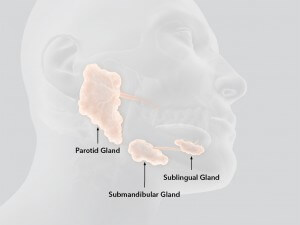It’s hard to believe that just a few years ago minimally invasive endoscopic treatments for obstructive salivary gland disorders didn’t exist. In the past the options for treating the pain and swelling were to cut open the duct to access and treat the blockage or to perform surgery to remove the entire salivary gland. Recovery time, the potential for temporary to permanent facial paralysis, scarring, and the loss of taste and sensation are some of the reasons that the search for new, alternative treatment options is crucial 1.
Symptoms of obstructive salivary gland disease can occur when blockages such as stones or strictures (narrowing of the duct) prevent the natural flow of saliva into the mouth. The major salivary glands affected are the parotid and submandibular glands. Patients who suffer with these blockages experience severe pain and swelling when they eat, drink, or even prepare meals 1.
Sialendoscopy, or salivary endoscopy, is a way to directly visualize stones and strictures by entering a gland with a micro endoscope. The procedure allows insertion of stone extractors and other interventional tools. This minimally invasive treatment option has the potential to save an otherwise healthy duct (tube that saliva flows through) by improving the flow of saliva without performing an invasive open surgery that may lead to complete loss of gland function. We rely on saliva to keep our mouth and teeth healthy as well as to provide the fluids necessary to swallow solid foods. Loss of saliva production can hinder our ability to maintain these natural digestive processes 2.
Through collaborative efforts with physicians in our clinical specialty, we continue to grow our suite of sialendoscopy products to provide minimally invasive treatment options for those who suffer with obstructive salivary gland disease. This Fall, we will be attending a sialendoscopy course hosted at the University of Toronto by Dr. Jack Kolenda on October 16-17, and a sialendoscopy workshop on November 6 at the University of California, San Francisco.
For more information on sialendoscopy visit cookmedical.com/otolaryngology and follow us on Twitter: @CookOHNS.
1Bates D, O’Brien CJ, Tikaram K, Painter DM. Parotid and submandibular sialadenitis treated by salivary gland excision. Aust N Z J Surg 1998;68:120-4.
2Prinz JF, Lucas PW. An optimization for mastication and swallowing. Proc R Soc Lond B 1997; 264:1715-1721.